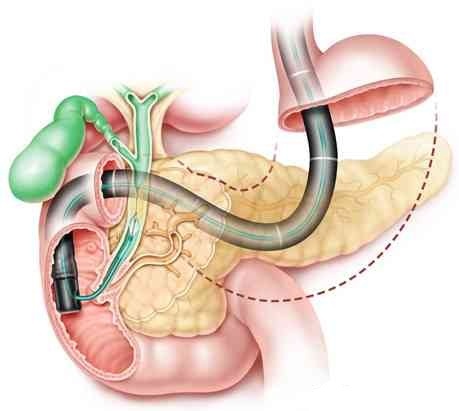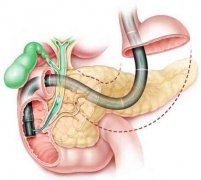 在慢性胰腺炎中全覆膜金属支架用于扩张持续胰管狭窄:一项前瞻性研究的长期随访。
在慢性胰腺炎中全覆膜金属支架用于扩张持续胰管狭窄:一项前瞻性研究的长期随访。
背景与目的:
内镜下置入单个或多个塑料支架有益于慢性胰腺炎(CP)继发的出现症状的主胰管(MPD)狭窄的治疗。而单个塑料支架置入难以解决MPD狭窄的问题。此项研究是用于评估使用可移除的全覆膜自膨胀金属支架(FC-SEMS)来扩张继发于CP的MPD狭窄效果的好坏。
方法:
将持续放置单个塑料支架3个月或更长时间的位于慢性胰腺炎患者和存在症状的胰腺头部主胰管狭窄患者纳入前瞻性单臂试验。置入镍钛合金的全覆膜金属支架(FC-SEMS, Bumpy支架,Taewoong,韩国)并于6个月后取出。FC-SEMS支架直径和长度的选择是根据狭窄的解剖结构和MPD直径来确定的,我们的主要研究指标是FC-SEMS支架的可移除性,次要指标是MPD狭窄消除概率和不良事件的发生。
结果:
2012年12月至2014年10月,共入选15例患者(男性10位,平均年龄60岁)。胰腺钙化者6例(40%)。四位(27%)存在酗酒史。10例患者经大乳头置入FC-SEMS支架,另外5位患者经小乳头置入支架。一名患者由于胆管开口被FC-SEMS支架阻塞,24小时后发展为胆管炎;此患者在插入胆道塑料支架后胆管炎症状好转。7位(47%)置入FC-SEMS支架者发生支架移位(5例无症状,2例有胰腺炎复发症状)。所有发生支架移位的,都是3厘米长的FC-SEMS支架。4位(27%)患者在扩张端出现FC-SEMS支架诱发的“新生”狭窄,均被排除在随访之外;1位置入FC-SEMS支架的移位患者狭窄扩张效果差。1位患者失访。最后9位MPD狭窄扩张的患者平均随访38.9个月(5.3~55.3个月),89%的患者无症
状。
结论:90%的患者3年后无症状,可取出胰管支架。3厘米长的FC-SEMS支架易在胰管中移动。FC-SEMS支架引起的胰腺狭窄是一个重要的问题,值得进一步评估。根据我们的经验,胰腺FC-SEMS支架对胰管狭窄有很好的效果,但临床试验需要仔细评估。
Fully covered self-expandable metal stents to dilate persistent pancreatic strictures in chronic pancreatitis: long-term follow-up from a prospective study.
Tringali A , Vadalà di Prampero, Salvatore Francesco, Landi R , et al. [J]. Gastrointestinal Endoscopy, 2018.
Abstract
BACKGROUND AND AIMS:
Symptomatic main pancreatic duct (MPD) strictures secondary to chronic pancreatitis (CP) may benefit from endoscopic insertion of single or multiple plastic stents. MPD stricture resolution after single plastic stents removal is uncommon. The use of removable fully covered, self-expandable metal stent (FC-SEMS) to dilate MPD strictures secondary to CP was evaluated.
METHODS:
Patients with CP and symptomatic MPD stricture located in the head of the pancreas persisting 3 months or more after placement of a single plastic stent were enrolled into a prospective single arm trial. A nitinol FC-SEMS (Bumpy stent, Taewoong, Korea) was inserted and removed after 6 months. The FC-SEMS diameter and length were chosen according to stricture anatomy and MPD diameter above the stricture. Our primary objective was FC-SEMS removability. Secondary objectives were MPD stricture resolution rate and adverse events.
RESULTS:
Between December 2012 and October 2014, 15 pts (10 male, mean age 60 years) were enrolled. Pancreatic calcifications were present in 6 (40%) cases. Four patients (27%) had a history of alcohol abuse. In 10 cases, the FC-SEMS was inserted through the major papilla, whereas 5 patients (3 pancreas divisum, 2 dominant dorsal duct) received the stent through the minor papilla. One patient developed cholangitis after 24 hours due to occlusion of the biliary sphincterotomy from the FC-SEMS; cholangitis resolved after insertion of a plastic biliary stent. Complete distal migration of the FC-SEMS was reported in 7 cases (47%) (5 asymptomatic, 2 symptomatic with recurrence of pancreatitis). All migrations occurred with the 3-cm-long FC-SEMS. Four patients (27%) developed "de novo" stricture induced by the FC-SEMS at the level of the flared end and were excluded from the follow-up; one patient with FC-SEMS migration had failed stricture resolution. One patient was lost to follow-up. Finally 9 patients with MPD stricture resolution had a mean follow-up of 38.9 months (range 5.3-55.3), and 89% of them were asymptomatic.
CONCLUSIONS:
FC-SEMS removability from the MPD in CP was feasible in all the cases and 90% of the patients were asymptomatic after 3 years. Migration seems more frequent with the 3 cm long FC-SEMS. Occurrence of FC-SEMS-induced pancreatic strictures is a major issue and deserves further assessment. According to our experience, pancreatic FC-SEMSs have promising results, but careful evaluation in the setting of clinical trials is needed.
KEYWORDS:
Chronic pancreatitis; Fully covered self-expandable metal stents; Pancreatic stricture; Personalized medicine
翻译:李国富 审校:张立超、侯森林


